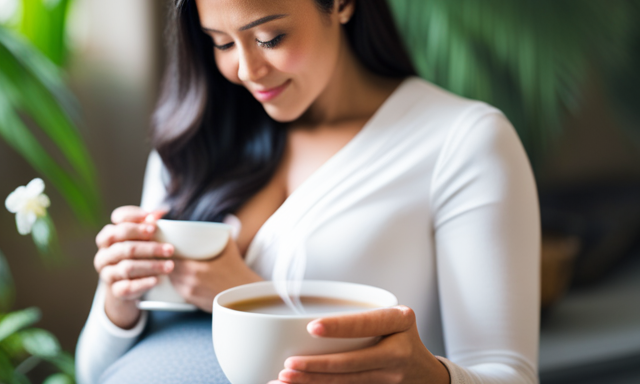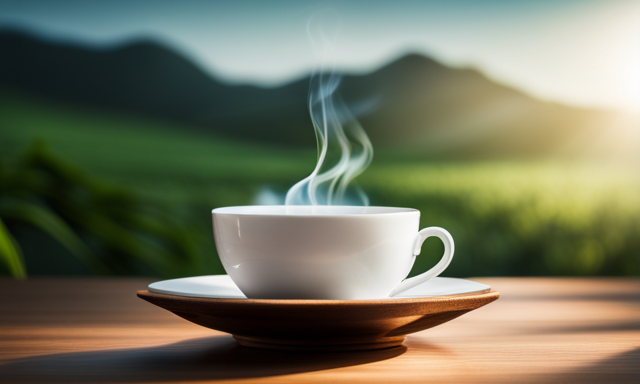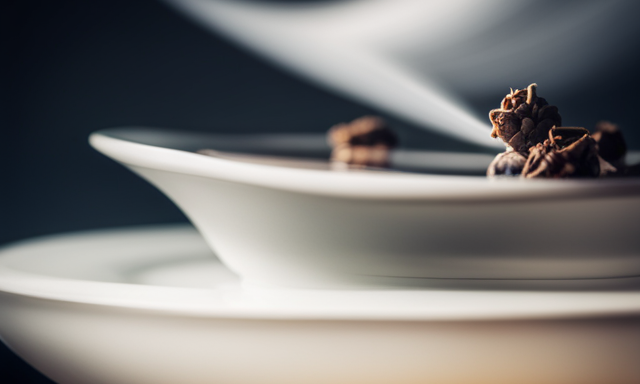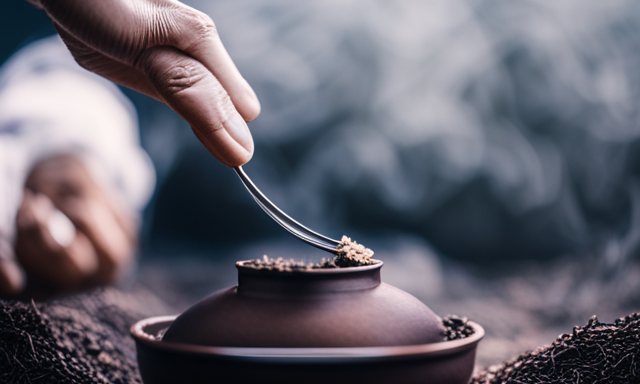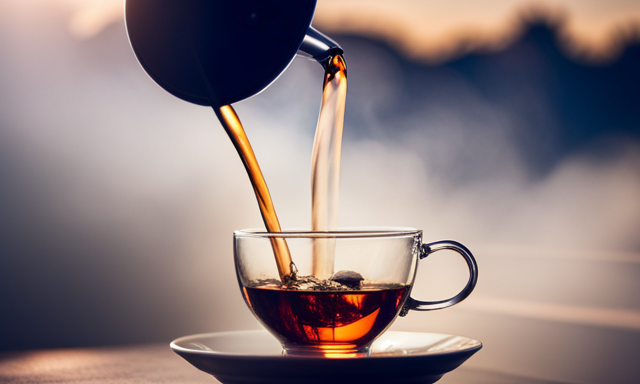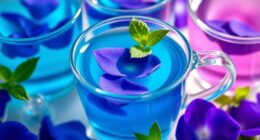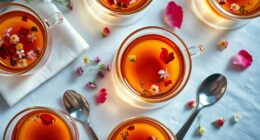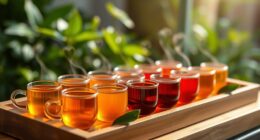Oolong tea, like a delicate dance between a vibrant green tea and a robust black tea, is a captivating brew that has intrigued tea enthusiasts for centuries. With its unique combination of flavors and aromas, oolong tea offers a delightful experience that is both refreshing and satisfying.
As a passionate tea lover, I am excited to share with you the wonders of oolong tea in this article.
In this comprehensive guide, we will explore the origins of oolong tea, its distinct characteristics, and the health benefits it offers. We will also delve into the art of brewing oolong tea and discover the popular varieties that are cherished by tea connoisseurs worldwide.
Additionally, we will discuss the art of pairing oolong tea with different types of food and explore the connection between oolong tea and mindfulness.
Join me on this journey as we dive into the fascinating world of oolong tea and uncover the secrets behind its enchanting flavors and captivating allure.
Key Takeaways
- Oolong tea is produced through a meticulous process of plucking and oxidizing leaves, resulting in a captivating aroma and robust flavor.
- Oolong tea holds an integral part in Chinese culture, emphasizing the art of tea making, appreciation of flavors, and observance of brewing techniques, tea utensils, and ceremony etiquette.
- Oolong tea complements a wide range of foods, creating delightful contrasts and enhancing flavors, making it an indulgent experience for the senses.
- Oolong tea provides mindfulness benefits such as calming the mind, enhancing focus and concentration, promoting relaxation and well-being, and encouraging a mindful and meditative state.
The Origins of Oolong Tea
If you’re curious about the origins of oolong tea, you’ll be fascinated to learn that it has a rich history rooted in the Fujian province of China. Oolong tea, also known as ‘Wulong’ tea, translates to ‘black dragon’ in Chinese, which perfectly captures its mysterious allure.
The exact origins of this tea are shrouded in legend and folklore, but it is believed to have been discovered by accident during the Ming Dynasty. Oolong tea is unique because it falls somewhere between green and black tea in terms of oxidation. The leaves are partially oxidized, resulting in a wide range of flavors and aromas. This delicate balance of oxidation gives oolong tea its distinctive taste and character.
Moving on to the characteristics of oolong tea…
Characteristics of Oolong Tea
When it comes to oolong tea, you’ll be captivated by its unique combination of floral and earthy notes, leaving you craving for more. Oolong tea flavors can range from light and fruity to rich and toasty, making it a versatile and complex beverage.
This is because oolong tea undergoes a partial oxidation process, which sets it apart from both green and black teas. The leaves are plucked and withered in the sun, then shaken or rolled to release the enzymes responsible for oxidation. The oxidation process is then halted by heating or roasting the leaves. This careful oolong tea processing creates a tea with a balance of flavors that is neither too strong nor too delicate. Its distinct taste is what makes it a favorite among tea connoisseurs.
Moving on to the health benefits of oolong tea…
Health Benefits of Oolong Tea
Indulge in the exquisite flavors of oolong tea and discover how it can enrich your well-being with its array of health benefits. Oolong tea offers numerous advantages that can enhance your overall health and promote weight loss. Here are five key benefits of oolong tea:
-
Boosts metabolism: Oolong tea contains polyphenols and caffeine, which can increase your metabolic rate and help burn calories.
-
Improves heart health: Regular consumption of oolong tea has been linked to a reduced risk of heart disease and lower blood pressure levels.
-
Enhances digestion: The antioxidants in oolong tea can aid digestion by reducing inflammation and promoting a healthy gut.
-
Supports brain function: Oolong tea contains theanine, an amino acid that can improve mental alertness and focus.
-
Promotes weight loss: Oolong tea can help control appetite and increase fat burning, making it a valuable addition to any weight loss plan.
Now, let’s move on to brewing oolong tea.
Brewing Oolong Tea
When it comes to brewing Oolong tea, two key factors to consider are water temperature and steeping time.
The ideal water temperature for Oolong tea is around 195 to 205 degrees Fahrenheit, which brings out the rich flavors and aromas without scorching the delicate leaves.
The steeping time can vary depending on personal preference, but generally, 3 to 5 minutes is a good range to extract the perfect balance of flavors.
As for teaware and infusion techniques, using a ceramic or clay teapot can enhance the brewing process by retaining heat and allowing the leaves to unfurl fully.
Additionally, practicing the Gongfu tea ceremony, which involves multiple short infusions in small teacups, can bring out the complexity and nuances of Oolong tea.
Water Temperature and Steeping Time
To achieve the perfect flavor, it’s crucial to steep oolong tea at the appropriate water temperature and for the correct amount of time. Oolong tea is delicate and requires a careful balance to bring out its unique characteristics. The water temperature should be around 180°F to 200°F (82°C to 93°C), which is below boiling point. Steeping oolong tea for too long can result in a bitter taste, so it’s important to follow the recommended steeping time of 2-3 minutes. This allows the leaves to unfurl and release their flavors without becoming overly strong.
To help you understand the importance of water temperature and steeping time, here’s a table that showcases the different characteristics you can expect based on these variables:
| Water Temperature | Steeping Time | Flavor Profile | Aroma |
|---|---|---|---|
| 180°F (82°C) | 2 minutes | Light and floral | Subtle and pleasant |
| 195°F (90°C) | 2.5 minutes | Balanced and smooth | Fragrant and inviting |
| 200°F (93°C) | 3 minutes | Rich and robust | Bold and aromatic |
By understanding the impact of water temperature and steeping time, you can enhance your oolong tea experience and enjoy its unique infusion techniques and health benefits. Now, let’s explore teaware and infusion techniques to further elevate your tea brewing journey.
Teaware and Infusion Techniques
Enhancing your oolong tea experience involves exploring teaware and mastering infusion techniques.
Investing in a diverse teaware collection can greatly enhance the flavor and aroma of your oolong tea. Different teapots and cups can bring out unique characteristics in the tea, allowing you to appreciate its complexity.
Understanding various tea infusion methods is crucial. Gongfu style, for example, involves using a higher tea-to-water ratio and shorter steeping times, resulting in a more concentrated and flavorful brew. Alternatively, you can opt for a more relaxed approach with a longer infusion time and larger teapot.
Experimenting with different infusion techniques can help you find the perfect balance of strength and nuance in your oolong tea.
Now, let’s dive into the popular varieties of oolong tea.
Popular Varieties of Oolong Tea
When it comes to popular varieties of Oolong tea, two names that definitely stand out are Tie Guan Yin, also known as Iron Goddess, and Da Hong Pao, which translates to Big Red Robe.
Tie Guan Yin is known for its floral aroma and smooth, mellow taste, making it a favorite among Oolong tea enthusiasts.
On the other hand, Da Hong Pao is highly prized for its rich and robust flavor, with hints of roasted nuts and chocolate.
Both of these Oolong teas have their own unique characteristics and are highly sought after by tea lovers around the world.
Tie Guan Yin (Iron Goddess)
The aroma of Tie Guan Yin oolong tea envelops you like a gentle embrace, its delicate floral notes swirling in the air. This popular variety of oolong tea is known for its unique production process and distinctive flavor profiles.
Tie Guan Yin is traditionally grown in the Fujian province of China and is meticulously hand-picked and processed to ensure its high quality. The leaves are carefully oxidized and roasted, resulting in a tea that strikes a perfect balance between green and black teas.
The flavor of Tie Guan Yin is complex and layered, with notes of orchid, honey, and a hint of roasted nuts. Its smooth and velvety texture leaves a lingering aftertaste that is both refreshing and satisfying.
Transitioning to the next subtopic, let’s explore the fascinating world of Da Hong Pao (Big Red Robe) oolong tea.
Da Hong Pao (Big Red Robe)
Immerse yourself in the enchanting allure of Da Hong Pao, as its rich history and mythical origins transport you to the rugged cliffs of Wuyi Mountain in China. Da Hong Pao, also known as Big Red Robe, is a highly revered oolong tea that holds a special place in Chinese tea culture. It is produced from tea bushes that have been cultivated for centuries, and the meticulous process involves plucking only the finest leaves and oxidizing them to perfection. The result is a tea that exudes a captivating aroma with a complex, robust flavor profile. With notes of roasted nuts, caramel, and a hint of floral sweetness, Da Hong Pao offers a truly indulgent experience for the senses. Its exquisite taste and long-lasting finish make it a cherished treasure among tea connoisseurs. Transitioning into the subsequent section about oolong tea in Chinese tea culture, we delve deeper into the significant role it plays in this ancient tradition.
Oolong Tea in Chinese Tea Culture
Explore the rich heritage of Chinese tea culture by savoring the distinct flavors and aromas of oolong tea.
Oolong tea, with its cultural significance, holds a special place in Chinese traditions. It is often enjoyed during tea ceremonies, which are an integral part of Chinese culture.
During these ceremonies, oolong tea is prepared and served with utmost care and precision, emphasizing the art of tea making and the appreciation of its flavors.
The unique characteristics of oolong tea, such as its floral and fruity notes, make it a delightful beverage to savor.
To fully immerse yourself in the Chinese tea culture, consider these three aspects:
1) The proper technique for brewing oolong tea,
2) The significance of tea utensils used during the ceremony, and
3) The etiquette and rituals observed during the tea ceremony.
As we delve into the next section about pairing oolong tea with food, let’s explore how its flavors can complement various culinary delights.
Pairing Oolong Tea with Food
Indulge in the delectable experience of pairing oolong tea with a variety of culinary delights and let your taste buds dance with delight.
Oolong tea, with its unique flavor profile, can complement a wide range of foods. One interesting pairing is oolong tea with cheese. The rich, complex flavors of oolong tea can harmonize with the creamy, salty notes of cheese, creating a delightful contrast.
Another intriguing combination is exploring oolong tea and chocolate. The earthy, floral undertones of oolong tea can enhance the sweetness and depth of chocolate, resulting in a truly indulgent experience.
As you sip on your oolong tea and savor these flavorful pairings, you will find yourself entering a state of mindfulness, fully present in the moment.
Transitioning into the subsequent section about oolong tea and mindfulness, let’s explore how this ancient tea can help us achieve inner calm and balance.
Oolong Tea and Mindfulness
Take a moment to steep in the tranquility of the present, allowing the delicate fragrance of oolong tea to gently unfurl in your mind like a blooming flower. Oolong tea not only offers a delightful and complex flavor profile, but it can also be a powerful tool in practicing mindfulness. Here are some mindfulness benefits of incorporating oolong tea into your daily routine:
- Helps calm the mind and reduce stress
- Enhances focus and concentration
- Promotes relaxation and a sense of well-being
- Encourages a mindful and meditative state
- Provides a moment of pause in a busy day
By savoring each sip of oolong tea, you can fully immerse yourself in the present moment and cultivate a greater appreciation for the simple pleasures in life.
Now, let’s explore the fascinating world of sustainability and oolong tea production.
Sustainability and Oolong Tea Production
Immerse yourself in the fascinating world of sustainability and discover how oolong tea is produced in an environmentally-conscious manner. Sustainability practices play a vital role in oolong tea production, ensuring that the environmental impact is minimized. From cultivation to processing, every step is carefully considered to maintain the delicate balance between nature and tea production.
To give you a glimpse into the sustainable practices employed, let’s take a look at a 3×3 table showcasing some key aspects:
| Sustainability Practices | Environmental Impact |
|---|---|
| Organic farming methods | Reduced pesticide use |
| Water conservation | Preserved water sources |
| Biodiversity preservation | Protected ecosystems |
By implementing these practices, oolong tea producers strive to minimize their carbon footprint and promote a healthy ecosystem. This commitment to sustainability ensures that future generations can continue to enjoy the exquisite flavors of oolong tea.
Now, let’s delve into the exciting world of exploring oolong tea variations.
Exploring Oolong Tea Variations
Discover the wide array of flavors and aromas found in different varieties of oolong tea, enticing your taste buds with their unique characteristics and leaving you wondering, ‘Which oolong tea variation will become your new favorite?’
Oolong tea, known for its partially oxidized leaves, offers a diverse range of flavors that can vary depending on the processing methods used. Here are five oolong tea variations that you should try:
-
Tie Guan Yin: This Chinese oolong tea has a floral aroma and a delicate, sweet taste.
-
Da Hong Pao: Originating from the Wuyi Mountains in China, this oolong tea has a roasted flavor with hints of stone fruit and caramel.
-
Oriental Beauty: This Taiwanese oolong tea is known for its honey-like sweetness and fruity notes.
-
Milk Oolong: With its creamy and buttery taste, this oolong tea is a favorite among tea enthusiasts.
-
Jin Xuan: Also known as ‘milk oolong,’ this Taiwanese tea has a smooth, milky flavor and a light floral aroma.
Each oolong tea variation offers a unique experience, allowing you to explore and appreciate the different flavors and aromas that oolong tea has to offer.
Frequently Asked Questions
How long does it take to brew oolong tea?
Oolong tea should be brewed for about 3-5 minutes at an optimal temperature of 180-200°F. This allows the leaves to unfurl and release their flavors, resulting in a rich and aromatic brew.
Can oolong tea help with weight loss?
Yes, oolong tea can help with weight loss. For example, a study showed that oolong tea increased metabolism by 10% and suppressed appetite. Its unique blend of antioxidants and caffeine contribute to these effects.
Is oolong tea high in caffeine?
Oolong tea is not only a delicious beverage, but it also has potential health benefits. It can promote heart health by reducing the risk of heart disease and may help regulate blood sugar levels.
What is the difference between oolong tea and black tea?
Oolong tea and black tea differ in taste and brewing methods. Oolong has a more complex and floral flavor profile, while black tea is stronger and bolder. Oolong requires shorter steeping times and lower water temperatures compared to black tea.
Are there any side effects of consuming oolong tea?
Oolong tea has potential health benefits like boosting metabolism and improving heart health. It is recommended to consume 2-3 cups per day. However, excessive intake may lead to caffeine-related side effects such as anxiety and sleep disturbances.
Conclusion
In conclusion, oolong tea is a versatile and complex beverage with a rich history and numerous health benefits. Its unique characteristics, including a range of flavors and aromas, make it a popular choice among tea enthusiasts.
Brewing oolong tea requires attention and precision, but the result is a flavorful and satisfying cup.
Whether enjoyed on its own or paired with food, oolong tea offers a sensory experience like no other, transporting you to a tranquil garden with each sip.


